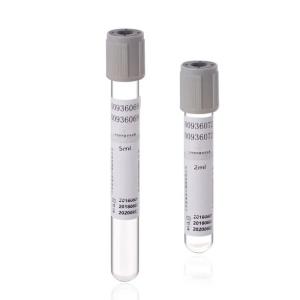
Add to Cart
Vacuum Blood Collection Glucose Tube
Vacuum Blood Collection Glucose Tubes are specifically designed to collect blood samples for glucose testing. These tubes contain an additive, typically sodium fluoride or sodium fluoride with potassium oxalate, which helps preserve the glucose in the blood sample and prevent its breakdown.
The collected blood samples in Vacuum Blood Collection Glucose Tubes are primarily used for measuring glucose levels in the blood, such as fasting blood glucose or random blood glucose tests. These tests are commonly performed to diagnose and monitor conditions such as diabetes, hypoglycemia, and hyperglycemia.
◆ Sodium fluoride and EDTA.Na2 are added to the blood collection tube. Sodium fluoride can effectively inhibit red blood cell glycolysis; EDTA.Na2 can greatly reduce the phenomenon of hemolysis, and ensure that the blood glucose data is constant within 72 hours.

◆ It can be used to collect and reserve blood specimens in blood glucose, glucose tolerance, red blood cell electrophoresis, anti-alkaline hemoglobin, sugar hemolysis and other items.
How to use the glucose tubes to test?
When using a Vacuum Blood Collection Glucose Tube for blood sample collection, the general steps are as follows:
Vacuum blood collection glucose tubes
Also known as glucose tubes or glucose vacutainers, are specialized tubes used for collecting blood samples specifically for glucose testing. These tubes are designed to ensure accurate and convenient measurement of glucose levels in the blood.
Here are some key points about vacuum blood collection glucose tubes:
Tube Design: Glucose tubes are typically made of glass or plastic and have a specific size and color to differentiate them from other types of blood collection tubes. The most common color for glucose tubes is gray, but it may vary depending on the manufacturer.
Anticoagulant/Additive: Glucose tubes usually do not contain any anticoagulant or additive. The purpose of these tubes is to collect a blood sample without interfering with the glucose measurement. Therefore, the tubes are sterile and free from substances that may affect glucose levels.
Blood Collection Process: The healthcare professional performing the blood draw attaches a needle to the glucose tube, punctures a vein, and allows the blood to flow into the tube. The tube is gently inverted to mix the blood with any residual additives or anticoagulants from previous tubes, although glucose tubes do not typically have any additives.
Glucose Testing: After blood collection, the glucose tube is sent to the laboratory for analysis. The blood sample is processed to measure the glucose levels using appropriate laboratory techniques, such as enzymatic methods or glucose oxidase methods.
Glucose testing is commonly performed to monitor and diagnose diabetes, a condition characterized by abnormal glucose metabolism. By measuring glucose levels in the blood, healthcare professionals can assess a person's glycemic control and make appropriate treatment decisions.
It's important to note that glucose testing can also be done using other types of blood collection tubes, such as serum tubes or plasma tubes, depending on the laboratory's preferred method. The choice of tube depends on the specific requirements of the laboratory and the testing protocol in use.
| Spec | Additive | Volume | Material |
| Φ13×75mm | EDTA.Na2+NaF | 2ml | Glass/PET |
| Φ13×75mm | EDTA.Na2+NaF | 3ml | Glass/PET |
| Φ13×75mm | EDTA.Na2+NaF | 4ml | Glass/PET |
| Φ13×100mm | EDTA.Na2+NaF | 3ml | Glass/PET |
| Φ13×100mm | EDTA.Na2+NaF | 4ml | Glass/PET |
| Φ13×100mm | EDTA.Na2+NaF | 5ml | Glass/PET |
| Φ16×100mm | EDTA.Na2+NaF | 6ml | Glass/PET |
Advantages
The vacuum blood collection tube adopts a fully automatic production line, and the quality is stable andreliable. According to diferent application area, blood collection tubes can be divided into serum bloodcollection tubes, plasma blood collection tubes, and whole blood collection tubes. lt is complete specification for the vacuum blood collection tube, and various special blood collection volumes and differentelevation tubes can be customized according to customer's special requirements.

Vacuum blood collection tubes, also known as vacuum tubes or vacutainers, are specialized tubes used for collecting blood samples for diagnostic testing. These tubes are designed to facilitate the collection, transportation, and processing of blood specimens in clinical laboratories.
Tube Design: Vacuum tubes are typically made of glass or plastic and come in various sizes, colors, and types, each intended for specific types of blood tests. The most common types include tubes for serum, plasma, whole blood, and specialized tests.
Vacuum System: The tubes contain a vacuum system, usually in the form of a rubber stopper or closure with a pre-attached needle or adapter. The vacuum inside the tube helps draw blood into the tube automatically when the needle punctures a vein.
Vacuum Tube Order of Draw: When multiple blood samples are required, there is a recommended order of draw to minimize cross-contamination between tubes and ensure accurate results. This order typically starts with tubes used for coagulation tests, followed by serum tubes, plasma tubes, and finally, tubes used for blood cell counts.
Additives and Anticoagulants: Vacuum tubes may contain various additives or anticoagulants depending on the type of test being performed. For example, tubes for serum tests usually do not contain any additives, while tubes for plasma tests may contain anticoagulants like heparin, EDTA, or citrate.
Collection Process: The healthcare professional performing the blood draw attaches a needle to the vacuum tube, punctures a vein, and allows the blood to flow into the tube. Once the required volume is collected, the tube is gently inverted to mix the blood with any additives or anticoagulants present.
Labeling and Transportation: After collection, the tube is labeled with patient information and other necessary details. It is then securely capped to prevent leakage and contamination. The tubes are typically transported to the laboratory for processing and analysis.
Vacuum blood collection tubes offer several advantages, including standardized sample volumes, reduced contamination risk, and improved safety for healthcare workers by minimizing exposure to blood. They have become a widely adopted method for blood collection in clinical settings due to their convenience and reliability.